tow MERCEDES-BENZ G-Class 2009 W463 Owner's Manual
[x] Cancel search | Manufacturer: MERCEDES-BENZ, Model Year: 2009, Model line: G-Class, Model: MERCEDES-BENZ G-Class 2009 W463Pages: 264, PDF Size: 6.98 MB
Page 26 of 264
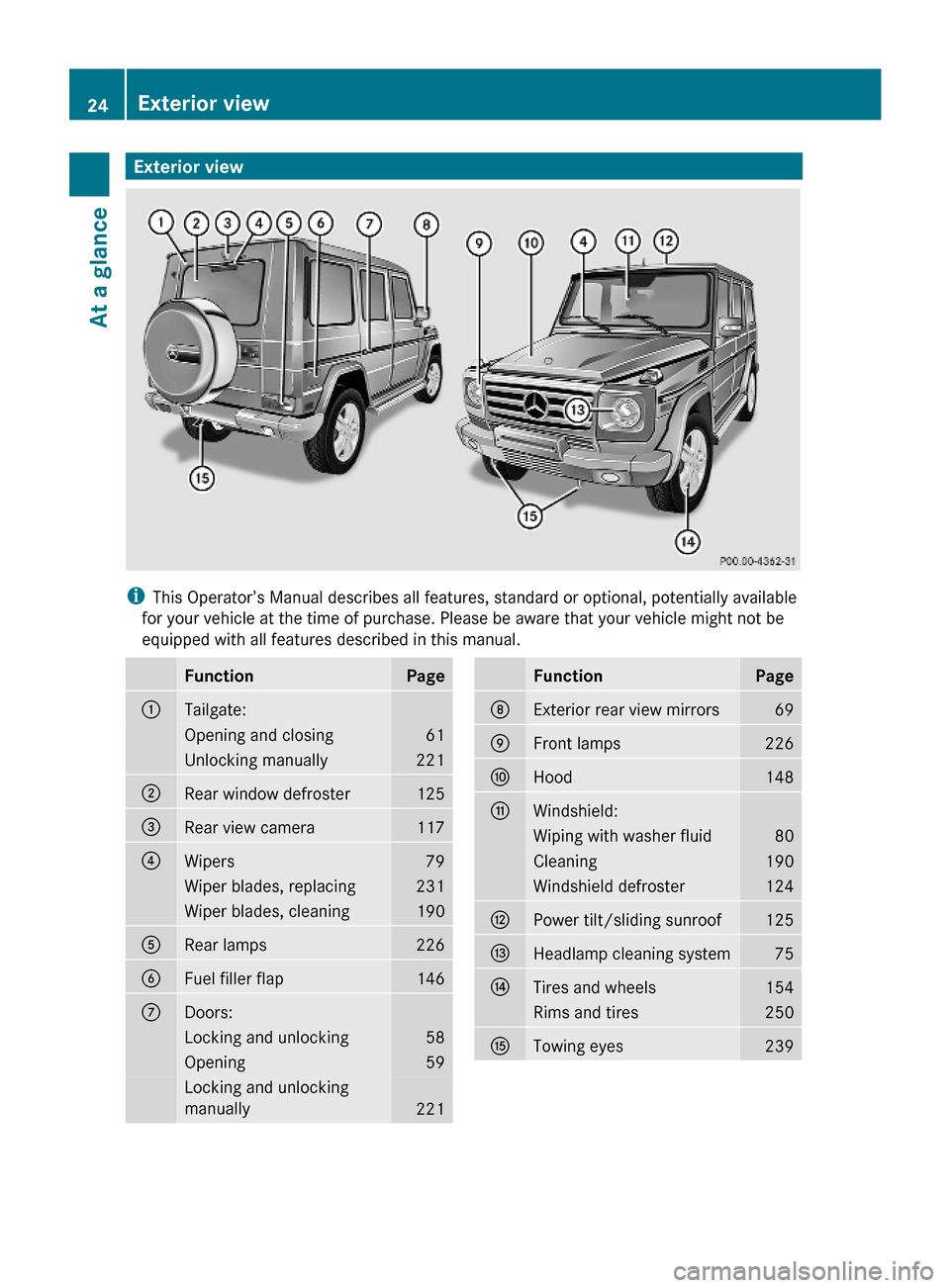
Exterior view
iThis Operator’s Manual describes all features, standard or optional, potentially available
for your vehicle at the time of purchase. Please be aware that your vehicle might not be
equipped with all features described in this manual.
FunctionPage:Tailgate:Opening and closing61Unlocking manually221;Rear window defroster125=Rear view camera117?Wipers79Wiper blades, replacing231Wiper blades, cleaning190ARear lamps226BFuel filler flap146CDoors:Locking and unlocking58Opening59Locking and unlocking
manually221
FunctionPageDExterior rear view mirrors69EFront lamps226FHood148GWindshield:Wiping with washer fluid80Cleaning190Windshield defroster124HPower tilt/sliding sunroof125IHeadlamp cleaning system75JTires and wheels154Rims and tires250KTowing eyes23924Exterior viewAt a glance
463_AKB; 2; 52, en-USd2ureepe,Version: 2.11.7.12008-12-02T10:52:11+01:00 - Seite 24
Page 30 of 264

FunctionPageAPress button & or *
briefly
•to move within a menu•to select previous or
next track, or stored
station within Audio/
DVD menu100
•to switch to the phone
book and select a name
or number within
Telephone menu110
Press and hold button
& or *
•to select previous or
next track with quick
search, or to select
previous or next station
in station list or wave
band within Audio/
DVD menu100
•to start the quick
search in the phone
book within Telephone
menu110
iCanada vehicles: The steering wheel in
this vehicle may vary from steering wheel
shown. However, multifunction steering
wheel symbols and feature description
apply to Canada vehicles as well.
iG 55 AMG: The steering wheel in this
vehicle may vary from steering wheel
shown. However, multifunction steering
wheel symbols and feature description
apply to AMG vehicles as well.
Center console
Upper part
FunctionPage:Seat heating switch,
driver’s side66
;Windshield defroster
switch124
=Rear window wiper/washer
switch80
?Electronic Stability
Program (ESP®) switch52
ADifferential lock switches93BCentral unlocking switch60Central locking switch60CAlarm system indicator
lamp54
Tow-away alarm off switch55DSeat heating switch, front
passenger side66
ESeat ventilation switch,
front passenger side66
28Center consoleAt a glance
463_AKB; 2; 52, en-USd2ureepe,Version: 2.11.7.12008-12-02T10:52:11+01:00 - Seite 28
Page 57 of 264
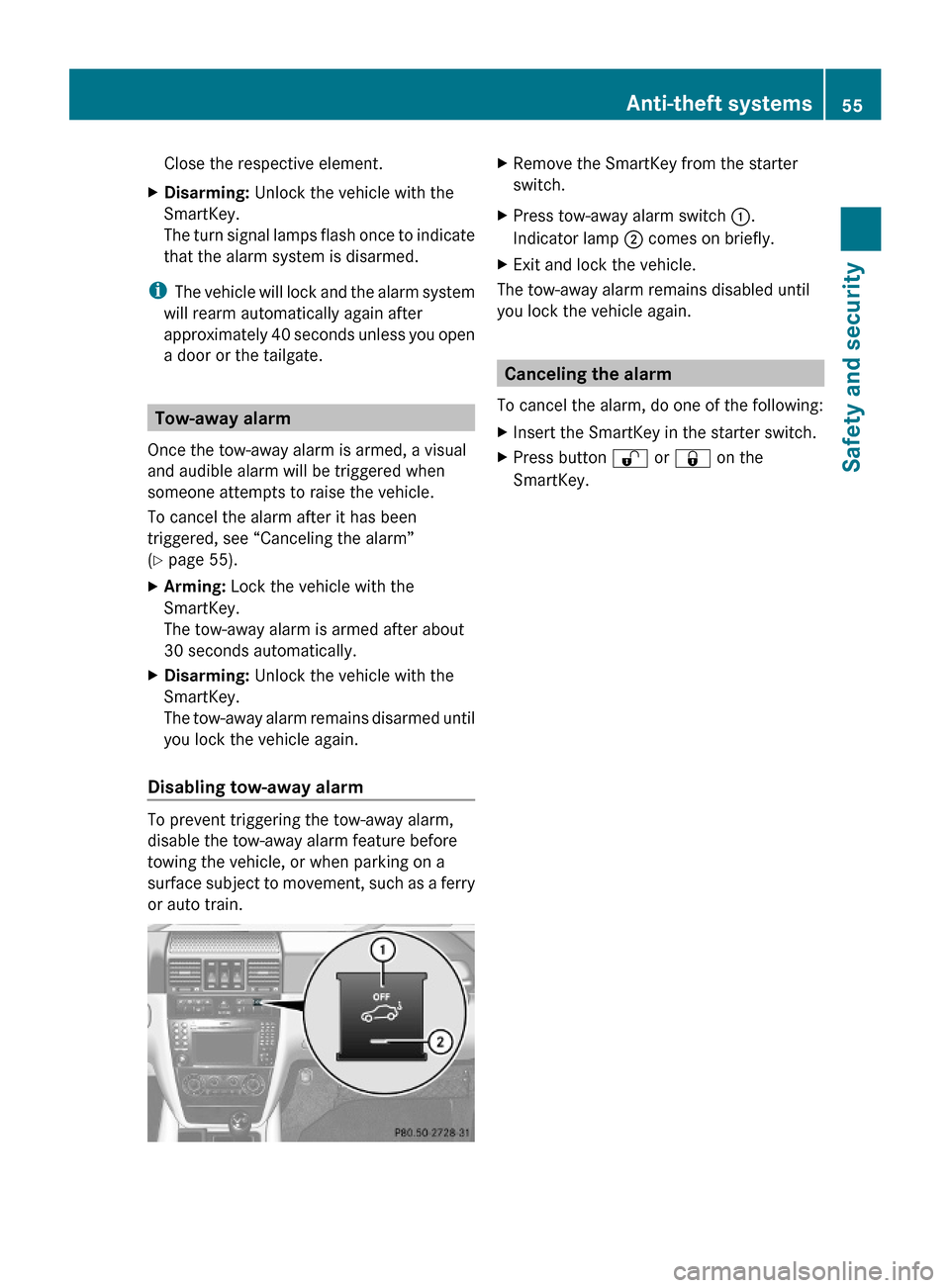
Close the respective element.XDisarming: Unlock the vehicle with the
SmartKey.
The turn signal lamps flash once to indicate
that the alarm system is disarmed.
iThe vehicle will lock and the alarm system
will rearm automatically again after
approximately 40 seconds unless you open
a door or the tailgate.
Tow-away alarm
Once the tow-away alarm is armed, a visual
and audible alarm will be triggered when
someone attempts to raise the vehicle.
To cancel the alarm after it has been
triggered, see “Canceling the alarm”
(Y page 55).
XArming: Lock the vehicle with the
SmartKey.
The tow-away alarm is armed after about
30 seconds automatically.
XDisarming: Unlock the vehicle with the
SmartKey.
The tow-away alarm remains disarmed until
you lock the vehicle again.
Disabling tow-away alarm
To prevent triggering the tow-away alarm,
disable the tow-away alarm feature before
towing the vehicle, or when parking on a
surface subject to movement, such as a ferry
or auto train.
XRemove the SmartKey from the starter
switch.
XPress tow-away alarm switch :.
Indicator lamp ; comes on briefly.
XExit and lock the vehicle.
The tow-away alarm remains disabled until
you lock the vehicle again.
Canceling the alarm
To cancel the alarm, do one of the following:
XInsert the SmartKey in the starter switch.XPress button % or & on the
SmartKey.
Anti-theft systems55Safety and security463_AKB; 2; 52, en-USd2ureepe,Version: 2.11.7.12008-12-02T10:52:11+01:00 - Seite 55Z
Page 62 of 264
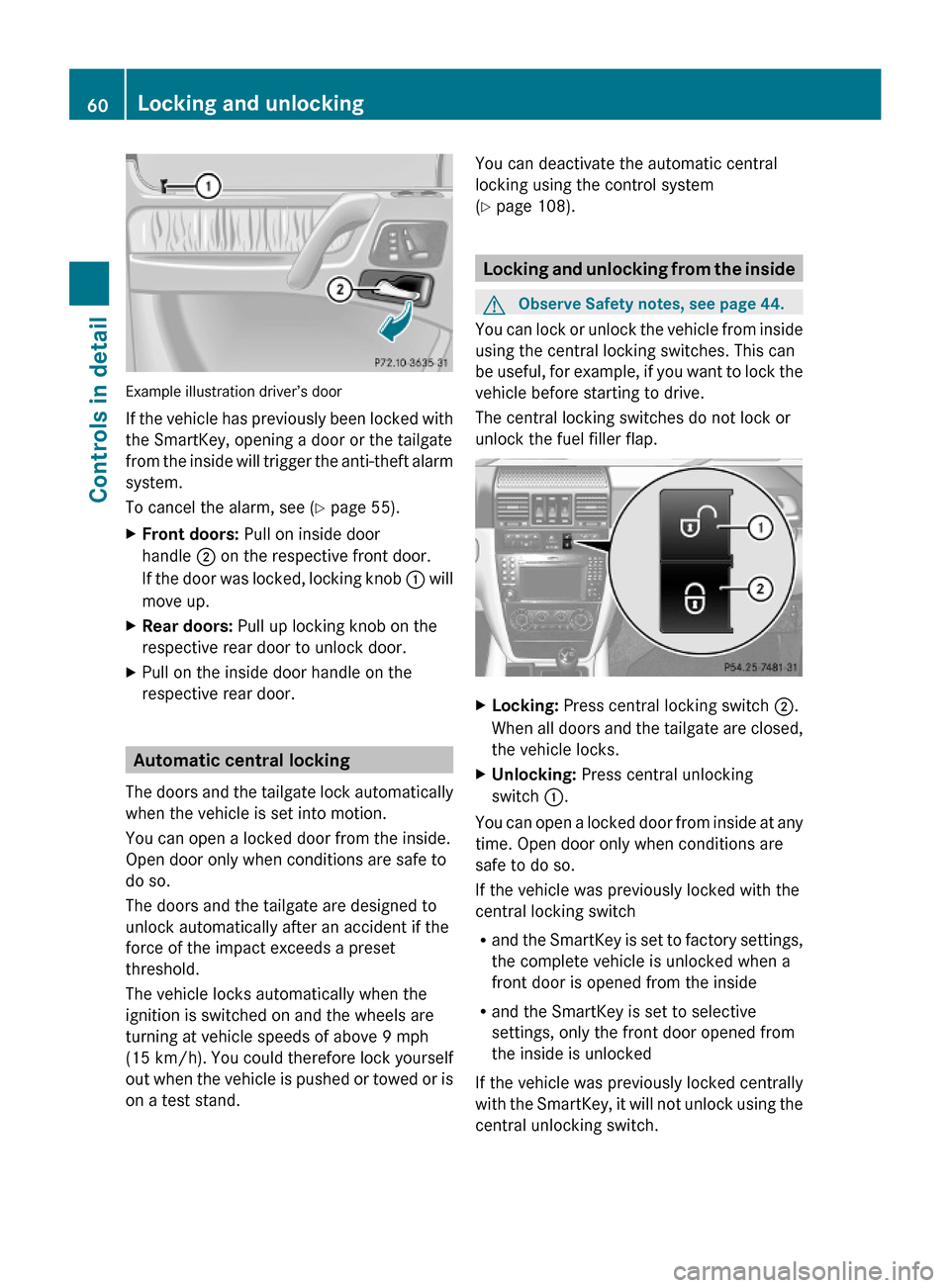
Example illustration driver’s door
If the vehicle has previously been locked with
the SmartKey, opening a door or the tailgate
from the inside will trigger the anti-theft alarm
system.
To cancel the alarm, see (Y page 55).
XFront doors: Pull on inside door
handle ; on the respective front door.
If the door was locked, locking knob : will
move up.
XRear doors: Pull up locking knob on the
respective rear door to unlock door.
XPull on the inside door handle on the
respective rear door.
Automatic central locking
The doors and the tailgate lock automatically
when the vehicle is set into motion.
You can open a locked door from the inside.
Open door only when conditions are safe to
do so.
The doors and the tailgate are designed to
unlock automatically after an accident if the
force of the impact exceeds a preset
threshold.
The vehicle locks automatically when the
ignition is switched on and the wheels are
turning at vehicle speeds of above 9 mph
(15 km/h). You could therefore lock yourself
out when the vehicle is pushed or towed or is
on a test stand.
You can deactivate the automatic central
locking using the control system
(Y page 108).
Locking and unlocking from the inside
GObserve Safety notes, see page 44.
You can lock or unlock the vehicle from inside
using the central locking switches. This can
be useful, for example, if you want to lock the
vehicle before starting to drive.
The central locking switches do not lock or
unlock the fuel filler flap.
XLocking: Press central locking switch ;.
When all doors and the tailgate are closed,
the vehicle locks.
XUnlocking: Press central unlocking
switch :.
You can open a locked door from inside at any
time. Open door only when conditions are
safe to do so.
If the vehicle was previously locked with the
central locking switch
Rand the SmartKey is set to factory settings,
the complete vehicle is unlocked when a
front door is opened from the inside
Rand the SmartKey is set to selective
settings, only the front door opened from
the inside is unlocked
If the vehicle was previously locked centrally
with the SmartKey, it will not unlock using the
central unlocking switch.
60Locking and unlockingControls in detail
463_AKB; 2; 52, en-USd2ureepe,Version: 2.11.7.12008-12-02T10:52:11+01:00 - Seite 60
Page 88 of 264

RTurn the SmartKey in the starter switch to
position 0 and remove the SmartKey from
the starter switch.
RTake the SmartKey with you and lock the
vehicle when leaving.
Parking brake
GWarning!
Engaging the parking brake while the vehicle
is in motion can cause the rear wheels to lock
up. You could lose control of the vehicle and
cause an accident. In addition, the vehicle’s
brake lights do not light up when the parking
brake is engaged.
GWarning!
When leaving the vehicle, always remove the
SmartKey from the starter switch, take it with
you, and lock the vehicle. Do not leave
children unattended in the vehicle, or with
access to an unlocked vehicle. Children could
release the parking brake and/or shift the
automatic transmission out of park position
P, either of which could result in an accident
and/or serious personal injury.
XReleasing: Pull up slightly on parking brake
lever : and press release button ;.
XPush parking brake lever : down to its
original position.
When the ignition is switched on or the
engine is running, the brake warning lamp
$ (USA only) or J (Canada only) in
the instrument cluster goes out.
XEngaging: Pull up parking brake lever :
firmly.
When the engine is running, the brake
warning lamp $ (USA only) or J
(Canada only) in the instrument cluster
comes on.
Turning off the engine
GWarning!
Do not turn off the engine before the vehicle
has come to a complete stop. With the engine
not running, there is no power assistance for
the brake and steering systems. In this case,
it is important to keep in mind that a
considerably higher degree of effort is
necessary to brake and steer the vehicle.
XShift the automatic transmission into park
position P.
XEngage the parking brake.
iAlways engage the parking brake in
addition to shifting the automatic
transmission into park position P.
When parked on an incline, also turn the
front wheels towards the road curb.
XTurn the SmartKey in the starter switch to
position 0.
XRemove the SmartKey from the starter
switch.
The immobilizer is activated.
The SmartKey can only be removed from the
starter switch with the automatic
transmission in park position P.
86Driving and parkingControls in detail
463_AKB; 2; 52, en-USd2ureepe,Version: 2.11.7.12008-12-02T10:52:11+01:00 - Seite 86
Page 91 of 264

EffectANeutral position
No power is transmitted from the
engine to the drive axle. When the
brakes are released, the vehicle can
be moved freely (pushed or towed).
To avoid damage to the
transmission, never shift the
automatic transmission into neutral
position N while driving.
Exceptions:
RIf the ESP® is deactivated or
malfunctioning, shift the
automatic transmission into
neutral position N if the vehicle is
in danger of skidding.
RShift the automatic transmission
into neutral position N if you have
to shift the transfer case.
! Coasting the vehicle, or driving
for any other reason with the
automatic transmission in neutral
position N can result in
transmission damage that is not
covered by the Mercedes-Benz
Limited Warranty.
7Drive position
The automatic transmission shifts
automatically. All forward gears are
available.
Driving tips
Kickdown
Use the kickdown when you want maximum
acceleration.
XDepress the accelerator pedal past the
point of resistance.
Depending on the engine speed the
automatic transmission shifts into a lower
gear.
Working on the vehicleGWarning!
When working on the vehicle, engage the
parking brake and shift the automatic
transmission into park position P. Otherwise
the vehicle could roll away which could result
in an accident and/or serious personal injury.
Gear ranges
With the automatic transmission in drive
position D, you can limit or extend the gear
range, see “One-touch gearshifting”
(Y page 90).
The current gear range appears in the
multifunction display.
:Gear range indicator
! If the transfer case is in off-road position
LOW, the automatic transmission will not
shift up automatically, even when the
engine has reached the speed limit for that
gear. There is a risk of damaging the
engine.
It is very important to make sure the
permissible engine speed is not exceeded.
Automatic transmission89Controls in detail463_AKB; 2; 52, en-USd2ureepe,Version: 2.11.7.12008-12-02T10:52:11+01:00 - Seite 89Z
Page 117 of 264
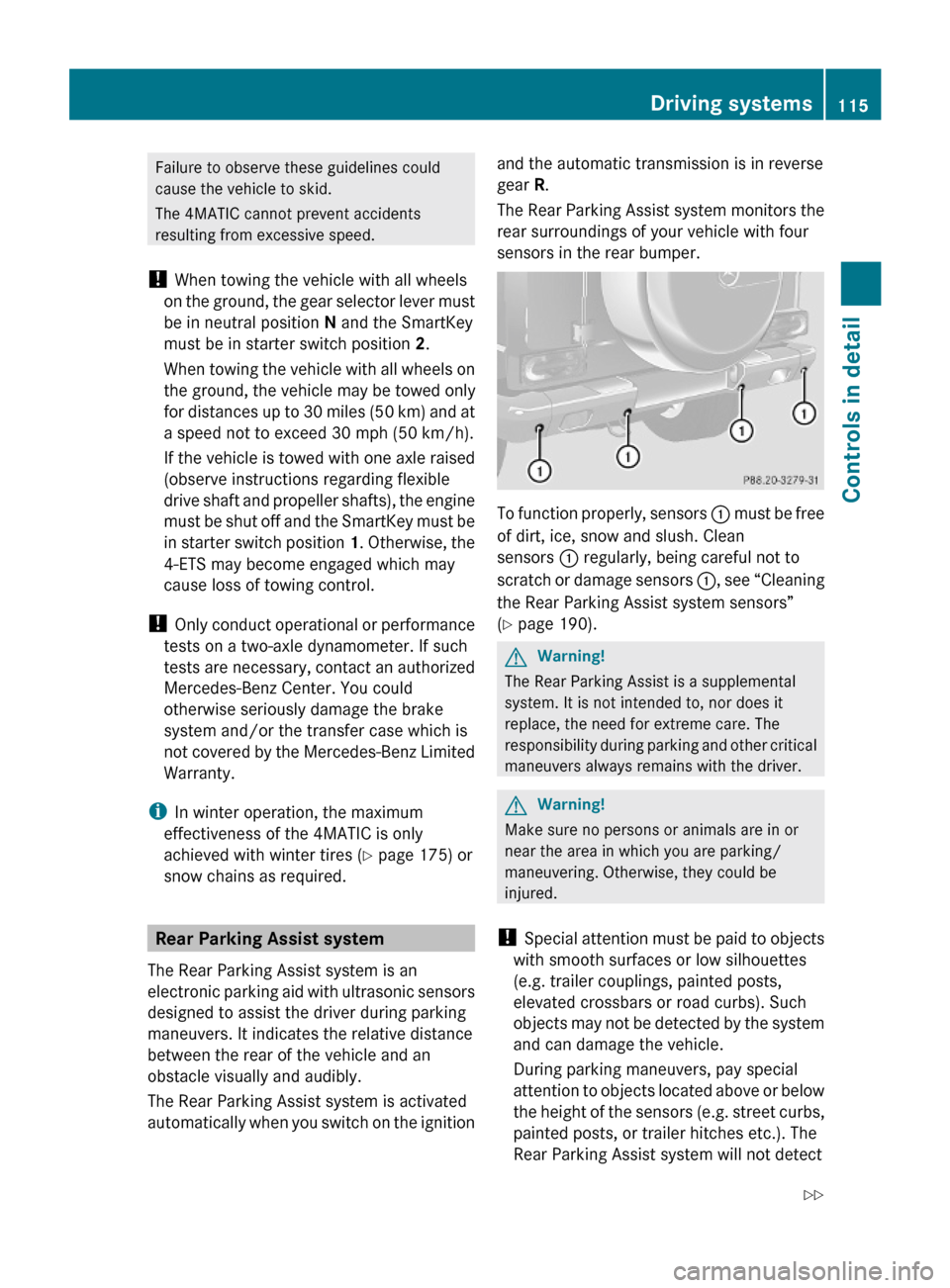
Failure to observe these guidelines could
cause the vehicle to skid.
The 4MATIC cannot prevent accidents
resulting from excessive speed.
! When towing the vehicle with all wheels
on the ground, the gear selector lever must
be in neutral position N and the SmartKey
must be in starter switch position 2.
When towing the vehicle with all wheels on
the ground, the vehicle may be towed only
for distances up to 30 miles (50 km) and at
a speed not to exceed 30 mph (50 km/h).
If the vehicle is towed with one axle raised
(observe instructions regarding flexible
drive shaft and propeller shafts), the engine
must be shut off and the SmartKey must be
in starter switch position 1. Otherwise, the
4-ETS may become engaged which may
cause loss of towing control.
! Only conduct operational or performance
tests on a two-axle dynamometer. If such
tests are necessary, contact an authorized
Mercedes-Benz Center. You could
otherwise seriously damage the brake
system and/or the transfer case which is
not covered by the Mercedes-Benz Limited
Warranty.
iIn winter operation, the maximum
effectiveness of the 4MATIC is only
achieved with winter tires (Y page 175) or
snow chains as required.
Rear Parking Assist system
The Rear Parking Assist system is an
electronic parking aid with ultrasonic sensors
designed to assist the driver during parking
maneuvers. It indicates the relative distance
between the rear of the vehicle and an
obstacle visually and audibly.
The Rear Parking Assist system is activated
automatically when you switch on the ignition
and the automatic transmission is in reverse
gear R.
The Rear Parking Assist system monitors the
rear surroundings of your vehicle with four
sensors in the rear bumper.
To function properly, sensors : must be free
of dirt, ice, snow and slush. Clean
sensors : regularly, being careful not to
scratch or damage sensors :, see “Cleaning
the Rear Parking Assist system sensors”
(Y page 190).
GWarning!
The Rear Parking Assist is a supplemental
system. It is not intended to, nor does it
replace, the need for extreme care. The
responsibility during parking and other critical
maneuvers always remains with the driver.
GWarning!
Make sure no persons or animals are in or
near the area in which you are parking/
maneuvering. Otherwise, they could be
injured.
! Special attention must be paid to objects
with smooth surfaces or low silhouettes
(e.g. trailer couplings, painted posts,
elevated crossbars or road curbs). Such
objects may not be detected by the system
and can damage the vehicle.
During parking maneuvers, pay special
attention to objects located above or below
the height of the sensors (e.g. street curbs,
painted posts, or trailer hitches etc.). The
Rear Parking Assist system will not detect
Driving systems115Controls in detail463_AKB; 2; 52, en-USd2ureepe,Version: 2.11.7.12008-12-02T10:52:11+01:00 - Seite 115Z
Page 129 of 264
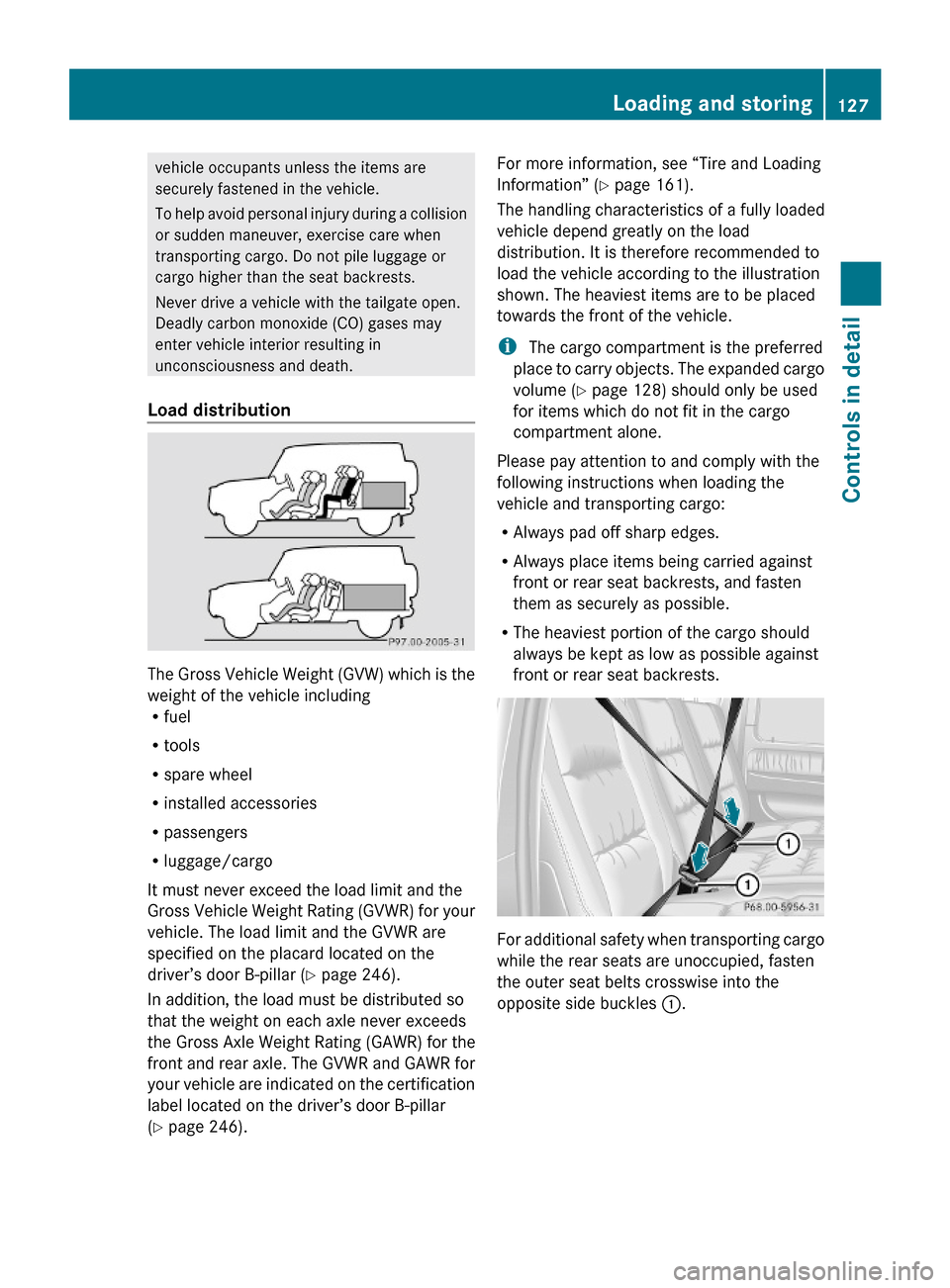
vehicle occupants unless the items are
securely fastened in the vehicle.
To help avoid personal injury during a collision
or sudden maneuver, exercise care when
transporting cargo. Do not pile luggage or
cargo higher than the seat backrests.
Never drive a vehicle with the tailgate open.
Deadly carbon monoxide (CO) gases may
enter vehicle interior resulting in
unconsciousness and death.
Load distribution
The Gross Vehicle Weight (GVW) which is the
weight of the vehicle includingRfuel
Rtools
Rspare wheel
Rinstalled accessories
Rpassengers
Rluggage/cargo
It must never exceed the load limit and the
Gross Vehicle Weight Rating (GVWR) for your
vehicle. The load limit and the GVWR are
specified on the placard located on the
driver’s door B-pillar (Y page 246).
In addition, the load must be distributed so
that the weight on each axle never exceeds
the Gross Axle Weight Rating (GAWR) for the
front and rear axle. The GVWR and GAWR for
your vehicle are indicated on the certification
label located on the driver’s door B-pillar
(Y page 246).
For more information, see “Tire and Loading
Information” (Y page 161).
The handling characteristics of a fully loaded
vehicle depend greatly on the load
distribution. It is therefore recommended to
load the vehicle according to the illustration
shown. The heaviest items are to be placed
towards the front of the vehicle.
i The cargo compartment is the preferred
place to carry objects. The expanded cargo
volume (Y page 128) should only be used
for items which do not fit in the cargo
compartment alone.
Please pay attention to and comply with the
following instructions when loading the
vehicle and transporting cargo:
RAlways pad off sharp edges.
RAlways place items being carried against
front or rear seat backrests, and fasten
them as securely as possible.
RThe heaviest portion of the cargo should
always be kept as low as possible against
front or rear seat backrests.
For additional safety when transporting cargo
while the rear seats are unoccupied, fasten
the outer seat belts crosswise into the
opposite side buckles :.
Loading and storing127Controls in detail463_AKB; 2; 52, en-USd2ureepe,Version: 2.11.7.12008-12-02T10:52:11+01:00 - Seite 127Z
Page 140 of 264
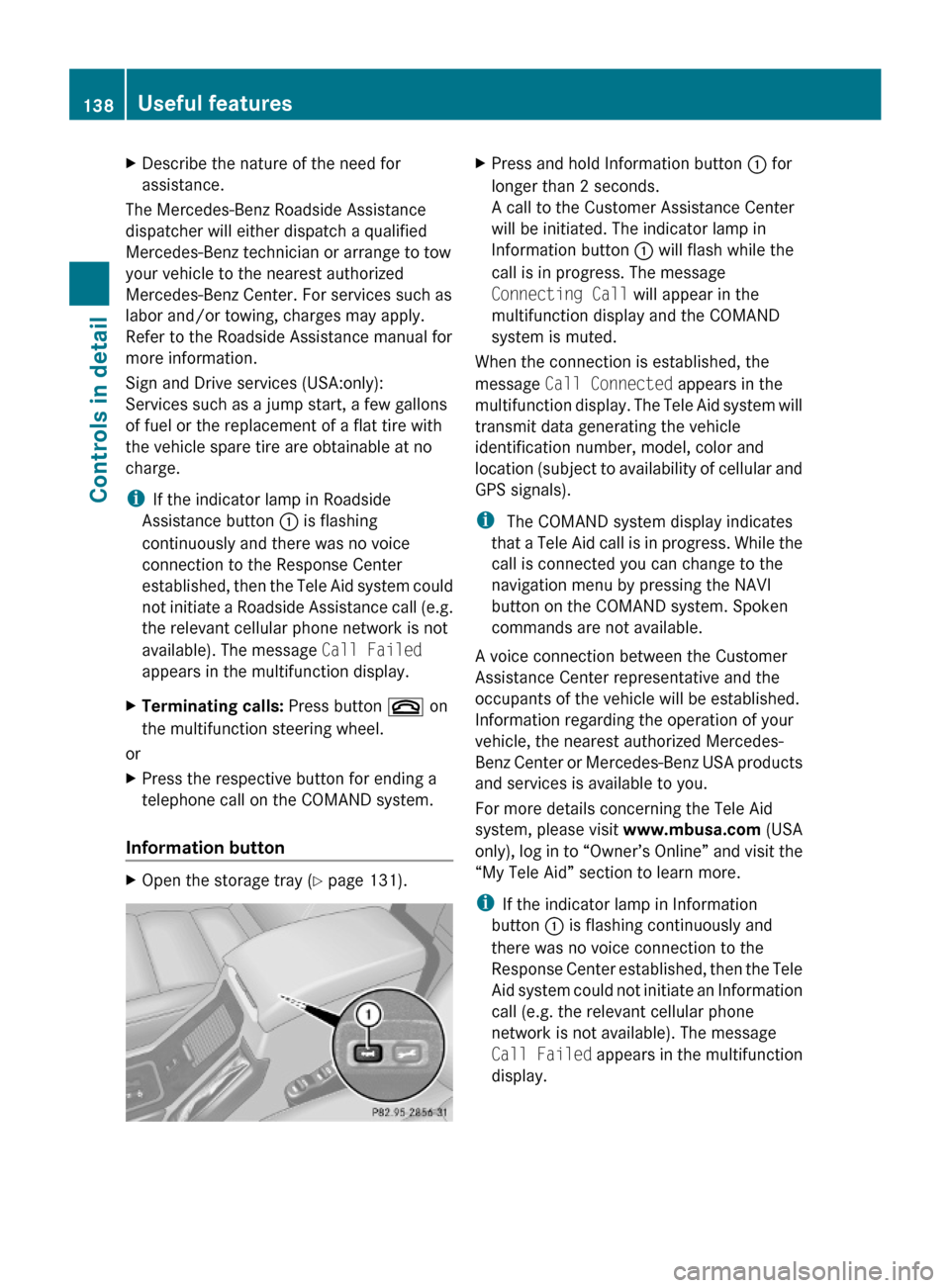
XDescribe the nature of the need for
assistance.
The Mercedes-Benz Roadside Assistance
dispatcher will either dispatch a qualified
Mercedes-Benz technician or arrange to tow
your vehicle to the nearest authorized
Mercedes-Benz Center. For services such as
labor and/or towing, charges may apply.
Refer to the Roadside Assistance manual for
more information.
Sign and Drive services (USA:only):
Services such as a jump start, a few gallons
of fuel or the replacement of a flat tire with
the vehicle spare tire are obtainable at no
charge.
iIf the indicator lamp in Roadside
Assistance button : is flashing
continuously and there was no voice
connection to the Response Center
established, then the Tele Aid system could
not initiate a Roadside Assistance call (e.g.
the relevant cellular phone network is not
available). The message Call Failed
appears in the multifunction display.
XTerminating calls: Press button ~ on
the multifunction steering wheel.
or
XPress the respective button for ending a
telephone call on the COMAND system.
Information button
XOpen the storage tray (Y page 131).XPress and hold Information button : for
longer than 2 seconds.
A call to the Customer Assistance Center
will be initiated. The indicator lamp in
Information button : will flash while the
call is in progress. The message
Connecting Call will appear in the
multifunction display and the COMAND
system is muted.
When the connection is established, the
message Call Connected appears in the
multifunction display. The Tele Aid system will
transmit data generating the vehicle
identification number, model, color and
location (subject to availability of cellular and
GPS signals).
i The COMAND system display indicates
that a Tele Aid call is in progress. While the
call is connected you can change to the
navigation menu by pressing the NAVI
button on the COMAND system. Spoken
commands are not available.
A voice connection between the Customer
Assistance Center representative and the
occupants of the vehicle will be established.
Information regarding the operation of your
vehicle, the nearest authorized Mercedes-
Benz Center or Mercedes-Benz USA products
and services is available to you.
For more details concerning the Tele Aid
system, please visit www.mbusa.com (USA
only), log in to “Owner’s Online” and visit the
“My Tele Aid” section to learn more.
iIf the indicator lamp in Information
button : is flashing continuously and
there was no voice connection to the
Response Center established, then the Tele
Aid system could not initiate an Information
call (e.g. the relevant cellular phone
network is not available). The message
Call Failed appears in the multifunction
display.
138Useful featuresControls in detail
463_AKB; 2; 52, en-USd2ureepe,Version: 2.11.7.12008-12-02T10:52:11+01:00 - Seite 138
Page 149 of 264

switch on the ignition. Otherwise the
incorrect or non-approved fuel will get into
the fuel lines. The fuel system must be
drained completely. Contact an authorized
Mercedes-Benz Center to have the fuel
system drained completely.
! To prevent damage to the catalytic
converters, only use premium unleaded
gasoline in this vehicle.
Any noticeable irregularities in engine
operation should be repaired promptly.
Otherwise, excessive unburned fuel may
reach the catalytic converter, causing it to
overheat and potentially start a fire.
i Only use premium unleaded gasoline with
a minimum Posted Octane Rating of 91
(average of 96 RON/86 MON).
Information on gasoline quality can
normally be found on the fuel pump. Please
contact gas station personnel in case
labels on the pump cannot be found.
For more information on gasoline, see
“Premium unleaded gasoline”
(Y page 254), see “Fuel requirements”
(Y page 255), or contact an authorized
Mercedes-Benz Center, or visit
www.mbusa.com (USA only).
The fuel filler flap is located on the right-hand
side of the vehicle towards the rear.
Locking/unlocking the vehicle with the
SmartKey automatically locks/unlocks the
fuel filler flap.
iIn case the central locking system does
not release the fuel filler flap, see “Fuel filler
flap” (Y page 223).
XTurn off the engine.
iLeaving the engine running and the fuel
filler cap open can cause the yellow fuel
tank reserve warning lamp to flash and the
malfunction indicator lamp = (USA
only) or ; (Canada only) to illuminate.
For more information, see also “Practical
hints” (Y page 218).
XRemove the SmartKey from the starter
switch.
XOpening: Press fuel filler flap : at the
point indicated by the arrow.
XTurn fuel filler cap ; counterclockwise.XTake off fuel filler cap ;.
! The fuel filler cap is tethered to the fuel
filler neck. Do not drop the cap. It could
damage the vehicle paint finish.
XPlace fuel filler cap ; in direction of arrow
into the holder.
XFully insert filler nozzle unit and refuel.XOnly fill your tank until the filler nozzle unit
cuts out – do not top off or overfill.
! When refueling the vehicle, make certain
that no gasoline comes into contact with
the rear side marker to prevent damaging
the lens.
XClosing: Turn fuel filler cap ; clockwise
until it audibly engages.
iMake sure to close the fuel filler flap
before locking your vehicle as the flap
At the gas station147Operation463_AKB; 2; 52, en-USd2ureepe,Version: 2.11.7.12008-12-02T10:52:11+01:00 - Seite 147Z